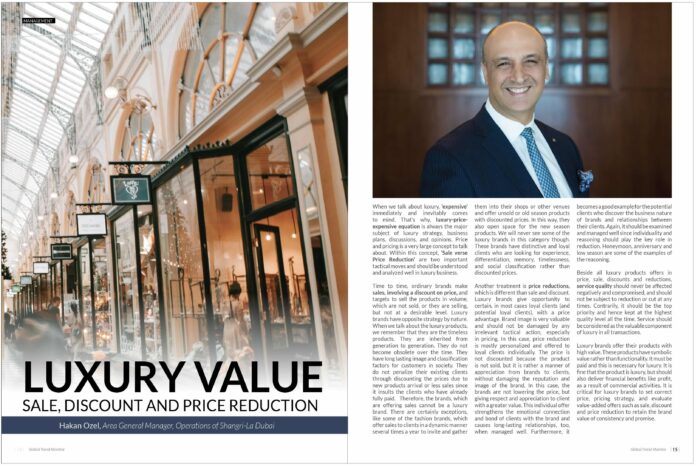Hakan Ozel, Area General Manager, Operations of Shangri-La Dubai
When we talk about luxury, ‘expensive’ immediately and inevitably comes to mind. That’s why, luxury-price-expensive equation is always the major subject of luxury strategy, business plans, discussions, and opinions. Price and pricing is a very large concept to talk about. Within this concept, ‘Sale verse Price Reduction’ are two important tactical moves and should be understood and analyzed well in luxury business.
Time to time, ordinary brands make sales, involving a discount on price, and targets to sell the products in volume, which are not sold, or they are selling, but not at a desirable level. Luxury brands have opposite strategy by nature. When we talk about the luxury products, we remember that they are the timeless products. They are inherited from generation to generation. They do not become obsolete over the time. They have long lasting image and classification factors for customers in society. They do not penalize their existing clients through discounting the prices due to new products arrival or less sales since it insults the clients who have already fully paid. Therefore, the brands, which are offering sales cannot be a luxury brand. There are certainly exceptions, like some of the fashion brands, which offer sales to clients in a dynamic manner several times a year to invite and gather them into their shops or other venues and offer unsold or old season products with discounted prices. In this way, they also open space for the new season products. We will never see some of the luxury brands in this category though. These brands have distinctive and loyal clients who are looking for experience, differentiation, memory, timelessness, and social classification rather than discounted prices.
Another treatment is price reductions, which is different than sale and discount. Luxury brands give opportunity to certain, in most cases loyal clients (and potential loyal clients), with a price advantage. Brand image is very valuable and should not be damaged by any irrelevant tactical action, especially in pricing. In this case, price reduction is mostly personalized and offered to loyal clients individually. The price is not discounted because the product is not sold, but it is rather a manner of appreciation from brands to clients, without damaging the reputation and image of the brand. In this case, the brands are not lowering the price, but giving respect and appreciation to client with a greater value. This individual offer strengthens the emotional connection and bond of clients with the brand and causes long-lasting relationships, too, when managed well. Furthermore, it becomes a good example for the potential clients who discover the business nature of brands and relationships between their clients. Again, it should be examined and managed well since individuality and reasoning should play the key role in reduction. Honeymoon, anniversary and low season are some of the examples of the reasoning.
Beside all luxury products offers in price, sale, discounts and reductions, service quality should never be affected negatively and compromised, and should not be subject to reduction or cut at anytimes. Contrarily, it should be the top priority and hence kept at the highest quality level all the time. Service should be considered as the valuable component of luxury in all transactions.
Luxury brands offer their products with high value. These products have symbolic value rather than functionality. It must be paid and this is necessary for luxury. It is fine that the product is luxury, but should also deliver financial benefits like profit, as a result of commercial activities. It is critical for luxury brands to set correct price, pricing strategy, and evaluate value-added offers such as sale, discount and price reduction to retain the brand value of consistency and promise.
